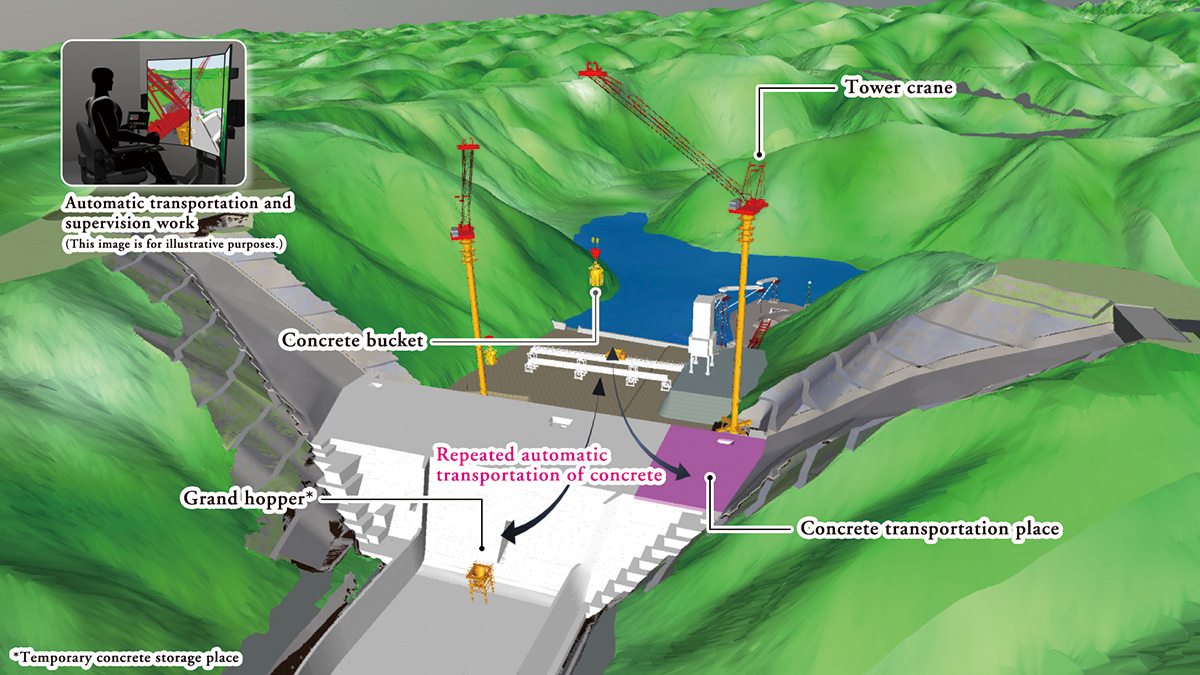- 4 Technology
- Technology Development
Automatic Concrete Transportation System Using a Tower Crane
We have developed an automatic concrete transportation system using a tower crane, which enhances productivity and safety by imitating operation by a skilled operator in dam construction.
Obayashi Corporation and Kitagawa Corporation (https://www.kitagawa.com/) have jointly developed a tower crane automatic concrete transportation system in dam construction, and have put it to practical use in the construction project of the main body of Kawakami Dam (https://www.water.go.jp/honsya/honsya/english/dams/kans_kawakami.html) ordered by the Japan Water Agency Incorporated Administrative Agency (https://www.water.go.jp/honsya/honsya/english/index.html) as one of the major technologies collected together in the Obayashi-Dam Innovative Construction Technology ODICT™.

In the construction of concrete dams, the transportation of concrete in construction sites, for example the transportation of large volumes of concrete by crane from the batcher plants, the concrete manufacturing facilities to the dam body placement sites, is important work which has a large impact on the progress of the project overall. In cable cranes, which were formerly the mainstream, Obayashi Corporation has carried out construction utilizing an automatic transportation system. On the other hand, considering the impact on the natural environment due to ground modifications resulting from cable crane installation, in recent years the adoption of construction using tower cranes has been increasing.
In crane work, the combined weight of the concrete and bucket transported at a single time sometimes approaches 20 tons, so advanced skills for keeping the load swing to a minimum are necessary in order to transport the load safely. However, repeated transportation over a long period of time imposes a large burden on the operator, and in addition in recent years there has been a shortage of crane operators possessing advanced skills, so ensuring safety in repetitive work and labor-saving in the work are required.
Therefore, on this occasion we have developed an automatic concrete transportation system which can use the largest class of tower crane in Japan (maximum operating radius of 86 m, lifting capacity with a load rating of 25 tons) and can remember and replicate the operations by skilled operators.
The features of the automatic concrete transportation system using a tower crane are as follows.
-
Replication of optimal transportation by a skilled operator
Crane work in dam construction is transportation over and over again of loads of almost equal weight every time between fixed points. This system employs the teaching/playback method which plays back operations remembered in advance. Once the system has been taught efficient transportation which keeps the load swing to a minimum by the skilled operator, it can repeatedly replicate that operation. Therefore, even if an inexperienced operator is on board, that operator can repeatedly carry out optimal transportation which replicates advanced skills.
In the future, we will operate this system in multiple cranes to achieve labor-saving by having a single operator supervise and manage their operational statuses, thereby enabling us to promote increases in productivity. -
The operator is liberated from the burden of operation, thereby enhancing safety
In conventional concrete transportation work, a large burden was imposed on the operator due to the repetitive work over a long period of time, and there was a possibility that this would lead to a decline in their ability to concentrate.
With this system, during the automatic transportation work, the operator is liberated from operation of the crane, so they can concentrate on the supervision work. Leaving the monotonous repeated transportation to the system alleviates the operator’s work burden, and at the same time advancing the transportation work more safely is possible. -
Detects the proximity of cranes and automatically stops
This system uses GNSS (a global positioning system), etc. to detect the position of the tip of the crane in real time, so it can detect proximity to other cranes. In the case that proximity is detected, the system issues an alert to the operator and at the same time stops the crane automatically.
- Management and
Organization- The Articles of Incorporation
- Basic Principles
- Transitioning of Corporate Symbol
- Corporate Officers
- Organization Chart
- Stock Information
- Financial Statements
- Technology
- BIM Timeline
- Awards
- Major Publication
- Group Companies
- Group Companies (in Japan)
- Group Companies (Overseas)